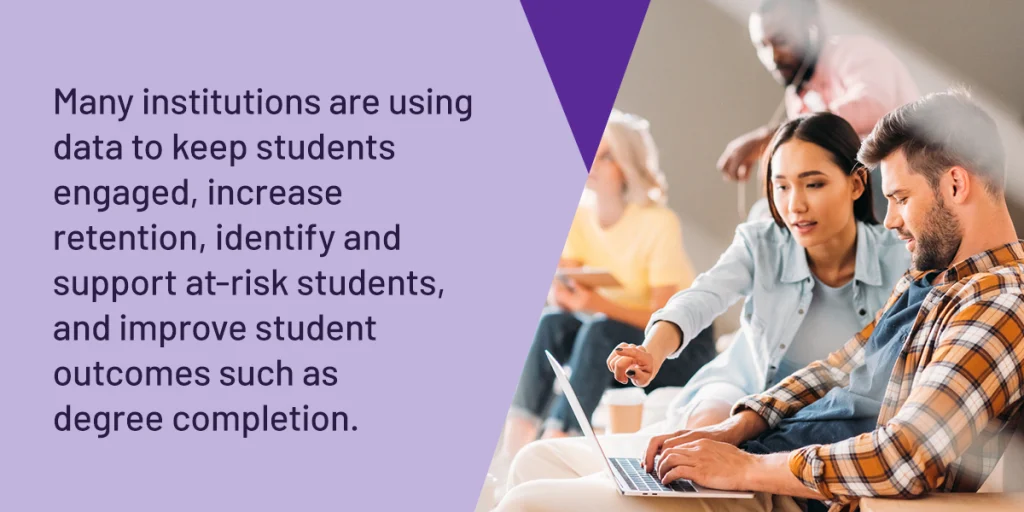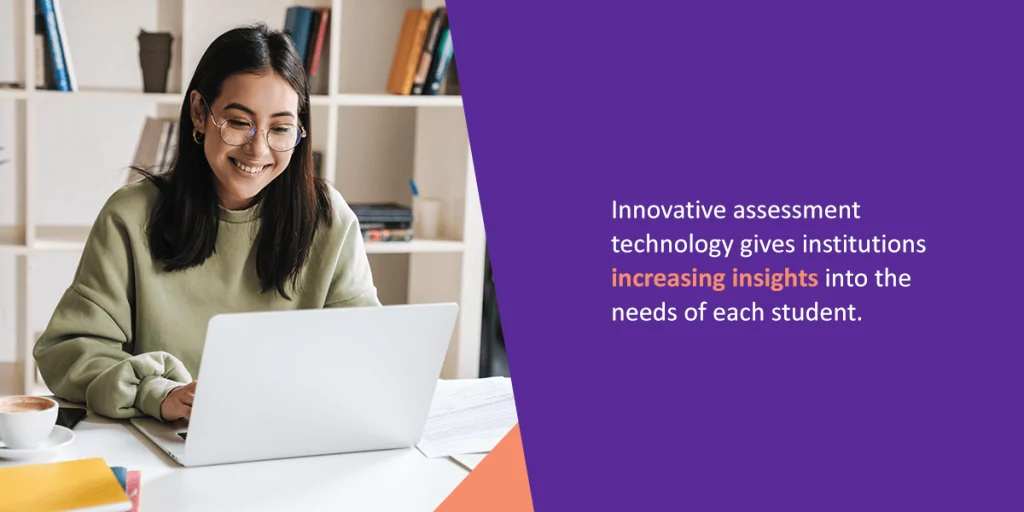
Assessment plays a pivotal role in the future of higher education as institutions constantly seek ways to improve the student experience, boost enrollment and retention, and prepare students for successful careers.
While the COVID-19 pandemic, the growth of artificial intelligence (AI), and cultural shifts in America’s opinion of higher education have resulted in many challenges, they have also forced institutions of higher learning to adopt new teaching and learning methods, ultimately shaping assessment processes.
Defining assessment in higher education
In simple terms, assessment in higher education measures what students know and what they can do. Educators and administrators gather information to better understand how students learn and discover strengths and weaknesses, not just in students but also in curricula and teaching methods.
Assessments also measure how student learning impacts the institution, making it a mutually beneficial process. Institutions have actionable data on which to base improvements, and students benefit from these improvements. In addition, assessments can inform resource allocation and educational planning. In short, assessment helps institutions confidently understand how to make the most significant impact in the lives of the students they serve.
9 trends in higher education assessment
How we assess learning is the backbone of student success. It drives institutional improvement and gives institutions valuable insights into how students perform and prepare for the workplace. Assessments present opportunities for improvement in teaching, assessing, and engaging students.
Over the years, student assessment has evolved to reflect the ever-changing educational landscape. The COVID-19 pandemic forced institutions to abruptly change their teaching and assessment strategies. AI has forced institutions to engage with what will likely be a permanent tool for both faculty and students. Accreditation agencies are recognizing the need for more disaggregated data that shows student learning for different demographics of students. These changes and others have prompted new trends in higher education assessment that include:
1. Shifting toward new assessment types
Summative assessment has long been the go-to assessment model for higher learning institutions. In recent years, however, the limitations of this model have become increasingly apparent. Summative assessments give students one way to demonstrate their knowledge at the end of an instructional period and often favor some students over others. It also limits ongoing feedback and widens the divide between students and educators.
In response, institutions have initiated more formative assessments throughout the course. This interactive format allows educators to tweak their approaches throughout an instructional period, addressing challenges or gaps in student knowledge as they arise.
Strategic assessment — using different assessment methods designed across an entire curriculum to assess specific outcomes in a given year — is another noteworthy trend. Educators assess students on activities that allow insight into how well they achieve program goals. Instead of legacy methods where programs were required to capture data on all outcomes, every semester, more institutions are focusing on looking at a sample of outcomes each semester, releasing some of the data-gathering pressure experienced by faculty.
2. Data-driven innovation
Data-driven decision-making has become the new norm in many institutions, and many are using data to keep students engaged, increase retention, identify and support at-risk students, and improve student outcomes such as degree completion.
With the enhanced ability to gather student data, institutions are making that data actionable and using it to drive improvement at all stages of the student journey. The ability to use data to drive success has resulted in a shift towards better assessment technology. In the long term, administrators and decision-makers can use the data to drive instructional best practices, increase student engagement, and inform curricula.

3. Leveraging data-informed, proactive advising
Formative assessment models combined with data can provide educators and success coaches with information on which students are struggling and how to engage with them. Early alerts notify advisors when students struggle, prompted by low scores on early assessment or low course enrollment. With this data, advisors can intervene at critical moments, providing students with actionable strategies for getting back on track and encouraging them to take advantage of study groups and learning centers.
In addition to facilitating advisor interventions, assessment data can prompt course redesign and further investigation into courses many students don’t finish. This assessment model has significant implications for institutions, and a proactive approach to handling struggling students can increase retention — a positive outcome for institutions in times of declining student enrollment.
4. Increasing leadership and stakeholder engagement
Assessment is becoming more of a culture than a practice in many institutions as more institution leaders and critical stakeholders experience the value of supporting student learning with data-driven decisions. When leaders use data to drive student participation and change educational programming to foster student engagement, this culture of improvement and student support filters throughout the institution.
Institutions will likely continue using more effective communication methods with stakeholders to gather feedback on how their assessments support student learning experiences. This trend represents a fundamental shift toward collaboration in higher education institutions as higher-level administrators are beginning to receive more insight into institutional effectiveness activities.
5. Increasing inclusivity
Each individual student who enters higher education has a background that influences their learning. Students from privileged backgrounds often find it easier to transition to the demands of higher education. In contrast, students from less privileged backgrounds may require more support to receive equal access to different resources and experiences.
Assessment findings can provide valuable information on which groups of students are leveraging the resources at their disposal and which may be falling behind. This data helps focus educators on closing the gaps and prioritizing engagement with all students for learning experiences that incorporate global affairs and diverse perspectives. Assessments are shifting away from standardization, focusing instead on allowing students to demonstrate their full potential in the ways that make most sense to them.
Additionally, more accreditation agencies are requiring institutions to report on student success disaggregated by student demographics. This kind of focus on a more granular approach to assessment helps institutions put resources towards students who may need additional support or curricula that may need improvement.
6. Expanding access to career-related experiences
Institutions are consistently looking beyond academic achievement. Instead, they focus on readying students for the challenges of entering a successful career. Experiential learning activities are essential for students to make informed career choices and enter the workplace with the required skills and confidence.
Experiential learning includes internships, field-based learning, service learning, and mentored research — and these require a different approach to assessment. Assessment methods will likely go beyond measuring attendance to focus on specific skills that help students clarify career goals and build relevant knowledge.
In addition, more institutions are recognizing that AI and the use of AI in daily work is likely going to increase. Helping students to critically consider how best to use AI ethically and efficiently will encourage the development of a new generation of workforce leaders who can leverage new technology to meet goals.
7. Upgrading assessment technology for data-driven improvements
Assessment practices continue to move away from limited and inefficient manual assessments in favor of faster and more secure digital processes. Institutions are no longer asking whether to integrate technology but rather how to integrate it best. Robust assessment technology provides students with many opportunities to demonstrate their skills and understanding, and stakeholders expect more frequent insights into student and educator performance.
Innovative assessment technology gives institutions increasing insights into the needs of each student. Gathering data from students creates an obligation to use that data to drive their success.

8. Prioritizing ongoing professional development
Ongoing professional development remains vital to creating and sustaining effective assessment processes. As assessment practices change, educators must have the opportunity to understand them. Ongoing professional development opportunities ensure that all educators and administrators at an institution have the tools to use innovative assessment practices. Institutions that embrace continued learning at all levels can also look forward to greater consistency in facilitating student success.
Institutions are likely to integrate more workshops and partnerships to ensure higher technology adoption rates and provide students with all the benefits of assessment methods and technology. Developing the workforce also fosters collaboration and creates cohesive assessment strategies that benefit educators, decision-makers, administrators, students, and the institution itself.
9. Continuing to innovate
Assessment is the key to ongoing student success in higher education. As the educational landscape evolves, institutions will continue to revise what they assess and the methods they choose for promoting student success. Trends that evaluate the whole student will continue to evolve, and more effective outcomes will undoubtedly be explored.
The future of assessment in higher education
As assessments continue to transform, higher education faces an exciting balance between embracing innovation and personalizing education. More than ever, assessment data will drive student success as institutions can preemptively intervene with struggling students, tailor the learning experience to each individual, and drive outcomes that prepare students for successful careers.
Educators will likely encounter new, more sophisticated alternatives to conventional systems for engaging with students individually and helping produce well-rounded, responsive members of society. Although this transition to technology-driven assessment may present some challenges, there are significant benefits on the other side. Most importantly, student assessment will remain focused on elevating the student experience through data so that every student might achieve their academic and professional goals.
Using assessment trends to elevate student success
The primary goal of assessment is to elevate the student experience and facilitate student success. Higher education institutions have a unique opportunity to balance innovative technology and a personalized approach to reshape the student experience.
Ready to reimagine your institution’s assessment goals? Request a demo today to learn how a robust digital assessment solution like Watermark Planning & Self-Study can help.













































































































































































































































































































































































































